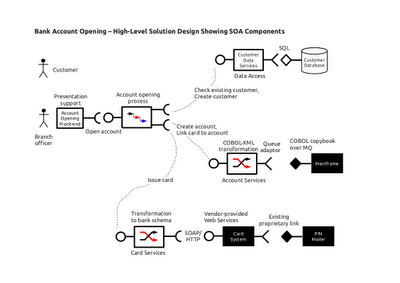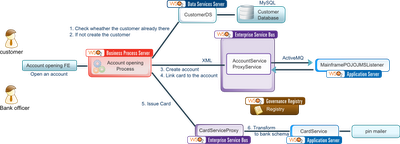IT people are biased towards the new, the cool and the "sexy". Perhaps Node.js and Cloud Computing fall into this category. Glamorous technology is very attractive, because it promises to be "the next big thing", but it's usually not usable today. Like Benjamin Franklin's proverbial new-born baby, it's full of potential, but does nothing for us in the here and now.
Contrast this with "workhorse technology", which is mature and relatively boring, and used to build working real-world systems that make or save money today. Not many people get excited about workhorse technology, but the majority of them work with it anyway, because it pays the bills.
I want to talk about one particular category of workhorse technology that I'm discovering can be quite glamorous as well. I have gradually become more familiar with this over the last few months of working with WSO2, writing the "Practical SOA for the Solution Architect" white paper, conducting a webinar and then hitting the road to conduct workshops in three Australian cities. I've realised that the combination of a lightweight SOA methodology in combination with a lightweight SOA product suite can be a very effective workhorse technology that is usable today and saves real dollars. In addition, it's actually pretty cool because of how quickly and easily it can help practitioners integrate diverse and distributed systems into an end-to-end business solution.
In a nutshell, in the white paper, webinar and workshops, I evangelise the message that SOA is not an esoteric and complex black art but simple commonsense that can be readily applied. I talk about the technology layer of SOA, of course, but also cover the equally important data layer that is often neglected and that contributes to the "tight coupling" that plagues so many solution designs and prevents them from realising the benefits of SOA. I talk about three core technology components to use (the Service Container, the Broker and the Process Coordinator) and when to use them, the inefficiencies that result from using the wrong tool for the job, and the dangers of treating the Broker as a singleton, centralised component and deploying it in a hub-and-spokes architecture rather than a federated one. I also cover four simple Data layer principles (make implicit dependencies explicit, remove unnecessary dependencies, loosely couple internal domain data with externally-visible message data, and settle on an intermediate granularity for domain data model(s) rather than a single overarching Canonical Data Model for the entire enterprise).
To drive home these concepts, we work through the real-world example of a well-known banking process, i.e., opening an account. Using the lightweight Practical SOA methodology, participants are encouraged to try their hand at producing an outline solution design to a described requirement in about 15 minutes, using a few standard Lego-style components from the SOA technology layer. Then we demonstrate how that solution design can actually be implemented, substituting each of the conceptual Lego blocks with an actual platform product that hosts the corresponding logic, and get the entire system to work.
To drive home these concepts, we work through the real-world example of a well-known banking process, i.e., opening an account. Using the lightweight Practical SOA methodology, participants are encouraged to try their hand at producing an outline solution design to a described requirement in about 15 minutes, using a few standard Lego-style components from the SOA technology layer. Then we demonstrate how that solution design can actually be implemented, substituting each of the conceptual Lego blocks with an actual platform product that hosts the corresponding logic, and get the entire system to work.
Here's a view of the conceptual building blocks that form the outline solution design, once the lightweight SOA methodology is applied to the business problem:
 In the next step, the conceptual components are replaced by actual WSO2 SOA products that perform each of those functions, and the physical version of the above diagram looks like this:
In the next step, the conceptual components are replaced by actual WSO2 SOA products that perform each of those functions, and the physical version of the above diagram looks like this:

 In the next step, the conceptual components are replaced by actual WSO2 SOA products that perform each of those functions, and the physical version of the above diagram looks like this:
In the next step, the conceptual components are replaced by actual WSO2 SOA products that perform each of those functions, and the physical version of the above diagram looks like this:
The Customer Master Database, the Mainframe and the Card System are all mock objects. A Data Services Server exposes the Customer Master as a set of CRUD services. A Broker (ESB) component exposes the mainframe as a set of Account services, and a second Broker exposes the Card System as a set of Card Services. Since the mainframe can usually only be accessed over IBM MQ in real-life, we simulate that through a JMS connection over ActiveMQ. A Process Coordinator (Business Process Server) coordinates all these services into a BPEL process that performs the account opening business function.
It was gratifying to see that participants at all the workshops we conducted were visibly impressed by this demonstration. In the space of 45 minutes, we had moved from a problem, through a conceptual solution design, to a working implementation. And since we had their active participation through the design exercise, they had an emotional investment in the solution and were able to appreciate it all the more. [To be fair, the demo was developed earlier over 6 person-days of effort, and in the workshop, we stepped quickly through the development by copying code that was written earlier.]
Traditional SOA vendors and the big-name analysts have done the industry a disservice by complicating SOA and scaring off practitioners. In our workshops, we've shown that SOA is just commonsense and relies on just a few simple principles that practitioners can readily apply. Once they know the right tools to use in the solution, it's a simple matter to gather those required components and hook them together to create the end-to-end solution.
This is obviously workhorse technology, because it's mature enough to solve bread-and-butter business problems today. But the lightweight methodology and product suite also make it glamorous.
I hope this attracts more practitioners towards the practice of lightweight SOA and the use of simple and cost-effective products like the WSO2 product suite.
2 comments:
How do you deal with a process where it varies by client. For example take a booking process, if there are differences in booking process between self-service b2c application vs call-center application, then do you create two different booking processes (process coordinators) one each for client or one booking process with lot of conditional logic.
Hi Laxman,
A lot depends on the details of the case. But in general, we're talking about two business processes with a lot of steps in common between them. I would be in favour of two separate processes that call the same service steps (largely) with slightly different logic here and there.
The Lego blocks are common. The arrangements are different. So we can have two different process definitions and still get a lot of reuse.
Regards,
Ganesh
Post a Comment